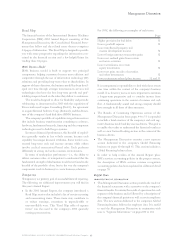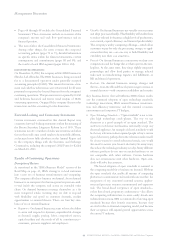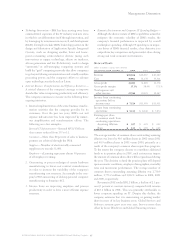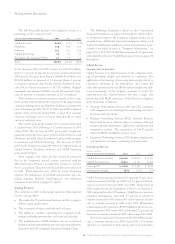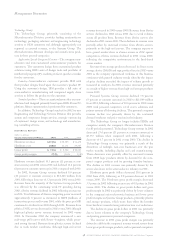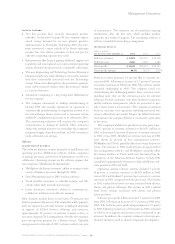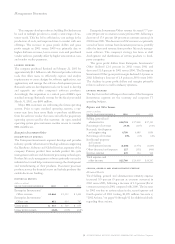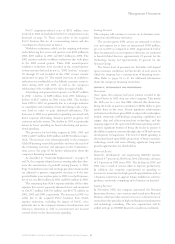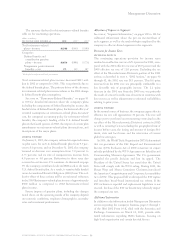IBM 2002 Annual Report Download - page 46
Download and view the complete annual report
Please find page 46 of the 2002 IBM annual report below. You can navigate through the pages in the report by either clicking on the pages listed below, or by using the keyword search tool below to find specific information within the annual report.
Management Discussion
44 international business machines corporation and Subsidiary Companies
■
Pages 64 through 69 include the Consolidated Financial
Statements. These statements include an overview of the
company’s income and cash flow performance and its
financial position.
■
The notes follow the Consolidated Financial Statements.
Among other things, the notes contain the company’s
accounting policies (pages 70 to 75), detailed information
on specific items within the financial statements, certain
contingencies and commitments (pages 88 and 89), and
the results of each IBM segment (pages 100 to 104).
discontinued operations
On December 31, 2002, the company sold its HDD business to
Hitachi, Ltd. (Hitachi). The HDD business is being accounted
for as a discontinued operation under generally accepted
accounting principles (GAAP). This means that income state-
ment and cash flow information were reformatted for all years
presented to separate the divested business from the company’s
continuing operations. This presentation is required by GAAP
and facilitates historical and future trend analysis of IBM’s
continuing operations. On page 80 the company discusses this
transaction and the accounting for the divestiture.
Forward-Looking and Cautionary Statements
Certain statements contained in this Annual Report may
constitute forward-looking statements within the meaning of
the Private Securities Litigation Reform Act of 1995. These
statements involve a number of risks, uncertainties and other
factors that could cause actual results to be materially different,
as discussed more fully elsewhere in this Annual Report and
in the company’s filings with the Securities and Exchange
Commission, including the company’s 2002 Form 10-K filed
on March 10, 2003.
Results of Continuing Operations
Description of Business
As mentioned in the “IBM’s Business Model” section of the
Road Map on page 43, IBM’s strategy is to lead customers
into a new era of business transformation and computing.
The company calls this e-business on demand. An on demand
business is an enterprise that has integrated its processes end-
to-end inside the company and across its extended value
chain. On demand businesses manage themselves as a far
more integrated whole, meaning they are able to respond
with flexibility and speed to customer demands, market
opportunities or external threats. There are four key attri-
butes of an on demand business:
■
Responsive: On demand businesses seem to have the ability
to sense and respond to dynamic, unpredictable changes
in demand, supply, pricing, labor, competitor’s moves,
capital markets and the needs of all its constituencies
—
customers, partners, suppliers and employees.
■
Variable: On demand businesses use variable cost structures
and adapt processes flexibly. This flexibility will enable them
to reduce risk and do business at high levels of productivity,
cost control, capital efficiency and financial predictability.
The company’s utility computing offerings
—
which allow
customers to pay for only the processing, storage, or appli-
cations that they use
—
are one way to build flexibility and
variability into their cost structures.
■
Focused: On demand businesses concentrate on their core
competencies and the things that set them apart in the mar-
ketplace. At the same time, they forge tightly integrated
partnerships and allow third parties to manage selected
tasks such as manufacturing, logistics and fulfillment, or
HR and financial operations.
■
Resilient: On demand businesses manage changes and
threats
—
from the ebb and flow of system usage to viruses or
natural disasters
—
with consistent availability and security.
Key business drivers that will influence IBM’s future results
are: the continued adoption of open technology standards;
technology innovations; IBM’s internal business transforma-
tion and efficiency initiatives; and the external economic
environment and corporate IT budgets.
■
Open Technology Standards
—
“Open standards” is not a com-
plex high technology catch phrase. The way we use
electricity is a good example of an open standard. The
outlets in each house and business universally accept any
electrical appliance. An example of closed standards would
be if every television maker required people to buy a certain
type of electricity, perhaps from the television maker itself.
So if you wanted to switch television brands, you would
also need to rewire your house’s electricity. In many ways,
this is how the technology industry is today. Many different
software products do not run on certain hardware or are
not compatible with other software. Certain hardware
does not communicate with other hardware. Open stan-
dards will solve this situation.
The broad adoption of open standards is essential to
the computing model for e-business on demand. Without
the open standards that enable all manner of computing
platforms to communicate and work with one another, the
integration of any customer’s internal systems, applica-
tions and processes remains a monumental and expensive
task. The broad-based acceptance of open standards
—
rather than closed, proprietary architectures
—
also allows
the computing infrastructure to more easily absorb new
technical innovations. IBM is committed to fostering open
standards because they benefit customers, because they
are vital to the on demand computing model, and because
their acceptance will expand growth opportunities across
the entire IT industry.











